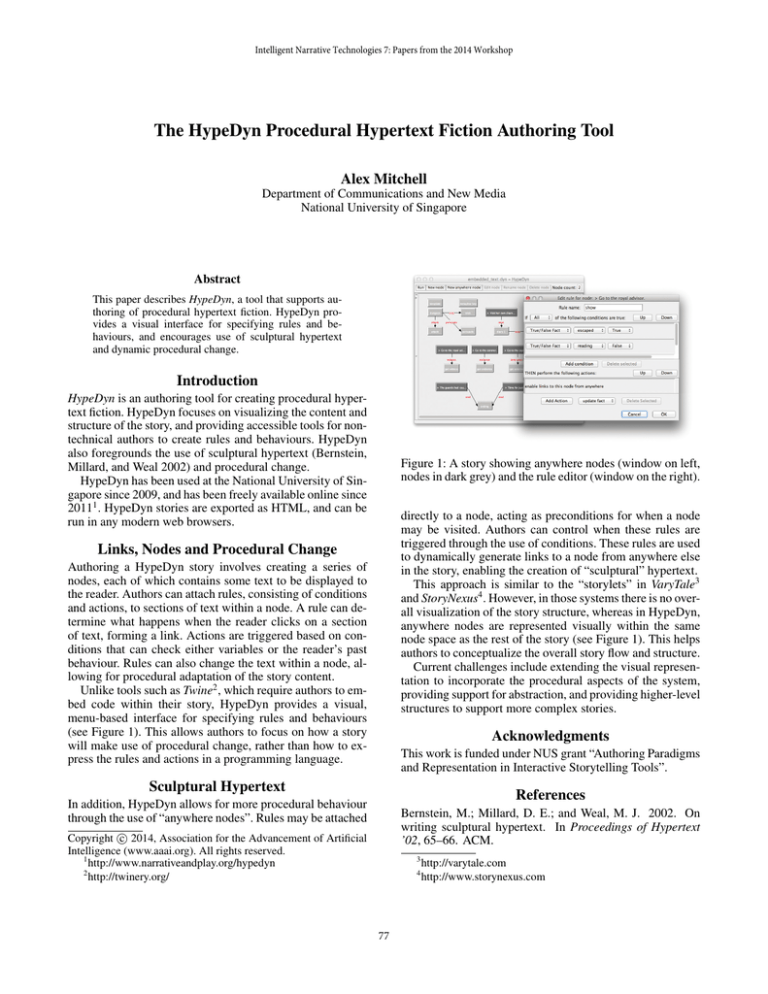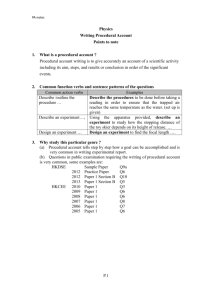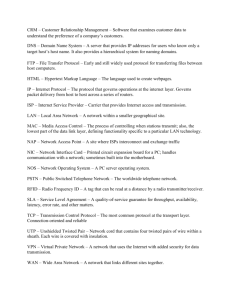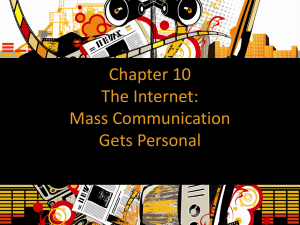
Intelligent Narrative Technologies 7: Papers from the 2014 Workshop
The HypeDyn Procedural Hypertext Fiction Authoring Tool
Alex Mitchell
Department of Communications and New Media
National University of Singapore
Abstract
This paper describes HypeDyn, a tool that supports authoring of procedural hypertext fiction. HypeDyn provides a visual interface for specifying rules and behaviours, and encourages use of sculptural hypertext
and dynamic procedural change.
Introduction
HypeDyn is an authoring tool for creating procedural hypertext fiction. HypeDyn focuses on visualizing the content and
structure of the story, and providing accessible tools for nontechnical authors to create rules and behaviours. HypeDyn
also foregrounds the use of sculptural hypertext (Bernstein,
Millard, and Weal 2002) and procedural change.
HypeDyn has been used at the National University of Singapore since 2009, and has been freely available online since
20111 . HypeDyn stories are exported as HTML, and can be
run in any modern web browsers.
Figure 1: A story showing anywhere nodes (window on left,
nodes in dark grey) and the rule editor (window on the right).
directly to a node, acting as preconditions for when a node
may be visited. Authors can control when these rules are
triggered through the use of conditions. These rules are used
to dynamically generate links to a node from anywhere else
in the story, enabling the creation of “sculptural” hypertext.
This approach is similar to the “storylets” in VaryTale3
and StoryNexus4 . However, in those systems there is no overall visualization of the story structure, whereas in HypeDyn,
anywhere nodes are represented visually within the same
node space as the rest of the story (see Figure 1). This helps
authors to conceptualize the overall story flow and structure.
Current challenges include extending the visual representation to incorporate the procedural aspects of the system,
providing support for abstraction, and providing higher-level
structures to support more complex stories.
Links, Nodes and Procedural Change
Authoring a HypeDyn story involves creating a series of
nodes, each of which contains some text to be displayed to
the reader. Authors can attach rules, consisting of conditions
and actions, to sections of text within a node. A rule can determine what happens when the reader clicks on a section
of text, forming a link. Actions are triggered based on conditions that can check either variables or the reader’s past
behaviour. Rules can also change the text within a node, allowing for procedural adaptation of the story content.
Unlike tools such as Twine2 , which require authors to embed code within their story, HypeDyn provides a visual,
menu-based interface for specifying rules and behaviours
(see Figure 1). This allows authors to focus on how a story
will make use of procedural change, rather than how to express the rules and actions in a programming language.
Acknowledgments
This work is funded under NUS grant “Authoring Paradigms
and Representation in Interactive Storytelling Tools”.
Sculptural Hypertext
References
In addition, HypeDyn allows for more procedural behaviour
through the use of “anywhere nodes”. Rules may be attached
Bernstein, M.; Millard, D. E.; and Weal, M. J. 2002. On
writing sculptural hypertext. In Proceedings of Hypertext
’02, 65–66. ACM.
c 2014, Association for the Advancement of Artificial
Copyright Intelligence (www.aaai.org). All rights reserved.
1
http://www.narrativeandplay.org/hypedyn
2
http://twinery.org/
3
4
77
http://varytale.com
http://www.storynexus.com




